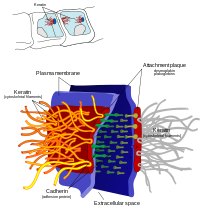 Daily Newsletter
Daily Newsletter
Cell Recognition and Junctions
Cells must have the ability to sense their environment, and part of this is to be able to sense and recognize other cells. In a multicellular organism, individual cells must be able to recognize other cells that are part of the same organism, and must be able to anchor to them. Ultimately, mutlicellularity requires cells to have some system whereby cells are anchored to each other.
For example: Would you be able to move if your muscles were not somehow anchored to the bone? Would your skin be a defensive structure if it separated when you pulled it? Would your cardiovascular system be able to transport blood if the pressure would rip open the vessels?
In terms of recognition, we also have to have the ability to determine if something is part of the "SELF" or foreign. We will find that the ability for cells to recognize each other will be an important concept in many areas of biology, most notably, immunology. The Major Histocompatability Complex Class I and II are two protein complexes (quaternary proteins) that are part of our "self recognition" system. The figure to the right shows a cartoon of MHC I, which is found on every nucleated cell in the body. MHC will become important in discussions on immunology. For now, remember that it is a cellular marker in our self recognition system.
When we talk about cell signaling, we will come back to the concept of cellular receptors, many of which are membrane bound proteins. Their job will be to pick up chemical signals around the cell, and then cause a response inside of the cell.
A linked topic to cellular recognition is cellular junctions. Cellular Junctions are points where two cells are anchored together through proteins and glycoproteins.
 There are numerous types of junctions, and some are specific to a group of organisms. The following three cellular junctions are associated with different animals, and provide a good foundation in the function of cellular junctions.
There are numerous types of junctions, and some are specific to a group of organisms. The following three cellular junctions are associated with different animals, and provide a good foundation in the function of cellular junctions.Tight Junctions - This is a cell junction found in vertabrates that holds cells tightly together, causing them to form a water proof layer. Water (and solutes) is not able to move through the intercellular (between cell) spaces. Instead solutions must pass through the cell (we regulate what moves through). This is important in organs like the stomach, intestines, and bladder.
Desmosomes - This type of cellular junction is designed to adhere cells together in a manner that is many times described as "spot-welding".
 Keratin plauges (waterproof structural protein) hold adhesion (anchoring) proteins. The adhsion holding plauges from different cells connect to form an incredibly strong and durable junction. The goal is to create a series of very strong connections between neighboring cells without creating a waterproof layer. These are found in areas of animal tissue that need to resist shearing or tearing forces.
Keratin plauges (waterproof structural protein) hold adhesion (anchoring) proteins. The adhsion holding plauges from different cells connect to form an incredibly strong and durable junction. The goal is to create a series of very strong connections between neighboring cells without creating a waterproof layer. These are found in areas of animal tissue that need to resist shearing or tearing forces.Gap Junctions - The previous two types of junctions were designed to hold the cell membranes of two cells together. While this also occurs with the gap junction, the ultimate goal is different. With the gap junction, cells are connecting their cytoplasm, forming a continuous cytosol (cellular solution) between the neighboring cells. This is critical for rapid movement of ions between cells. This type of junction is used to communicate electrical changes (action potentials/nerve impuses) from one cell directly to another cell. The gap junction will come up again in discussions about action potential, neural function, and heart muscles.

Daily Challenge: Junctions and Recognition
Explain why cellular junctions and cellular recognition are important to multicellular organisms. Use MHC and desmosomes as examples of cellular recognition proteins and junction proteins. Also discuss how we are using membrane bound proteins to make these recognition points and junctions. Do you think you are born with all the recognition points and junctions, or can you change them over time?Link to Forum
No comments:
Post a Comment